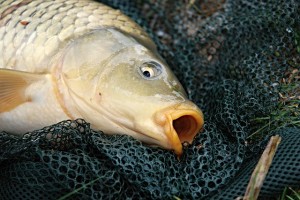 Choosing a location to catch carp is the most important step when going carp fishing. You must first know whether carp even exist in that body of water. Not all waters have a carp population in them so you need to find out before you waste your time.
Choosing a location to catch carp is the most important step when going carp fishing. You must first know whether carp even exist in that body of water. Not all waters have a carp population in them so you need to find out before you waste your time.
If its not your first time to a particular body of water then you should already have a good idea whether carp are present. Their presence is easily detected if you spend some time on the water. You can often see them sitting just below the surface or even jumping out of the water. Male carp jump frequently when spawning. They also create quite a swirl when they get spooked, much larger than that of most fresh water fish. Bubble trails can also be a good indication of carp. And if you really can’t find them on your own, ask other fishermen or locals. These fish are huge and usually don’t go unnoticed, so finding this information shouldn’t be difficult.
To catch a carp your going to need some tackle that can handle these fish. Don’t underestimate their size and strength, it can sometimes feel like they’re going to pull you in they’re so strong. Hooking up with a carp can take a lot of time and effort so the last thing you want to see happen is your line break or your tackle fail. Don’t get me wrong, I’ve caught carp on my bass fishing rods in the past but its a whole lot easier and better with the right equipment.
The best carp rods are 12 feet long, very powerful, and have a soft tip. They work best with a strong spinning reel. I say powerful and strong because they are going to be under some heavy stress, as heavy as freshwater fishing gets anyway. Your going to need a strong line that can handle some abrasion, so a minimum of 12 pound test is recommended. Most carp anglers use between 12 and 20 pound test monofilament.
As far as hooks, the mouth on a carp is not very big, so a popular size is 14. You also want to make sure you get barbless hooks, they hold just as good and are much easier to unhook from their tiny mouths. How you choose to rig the hook can vary and you should make adjustments until you find success. There are tons of variations but you can catch carp with simply a baited hook. Although you may want to add a sinker to help you cast further and to get the bait down to the bottom quicker. Theres so many different ways to rig for carp that I can’t list them all here. If you want to learn more carp fishing rigs visit the Carp Fishing Websites page, you will find a ton of information on those sites.
So you have your fishing spot and proper tackle, all you need is some bait and your ready to start catching carp right? Unfortunately it’s not that simple. If you were to cast your bait out and wait for carp to find it you could be waiting a very long time. Think about how much water a carp would have to cover before it found your tiny hook. Carp fishing is all about attracting them to your area by feeding them first. You do this by using groundbait, which is bait that is cast in to the water to attract fish to your area. This can be as simple as using pieces of bread or sweet corn, or as advanced as making up a mixed groundbait. Theres many recipes for making your own groundbait so I won’t be getting in to that here but you will find plenty of that information on the Carp Fishing Websites page. Whichever you decide to use you will begin by throwing it in to the water to get the carp feeding. You want to disperse the groundbait out a but not so much that the fish will be spread too far apart. Your goal is to try to get them feeding in roughly a 20’ x 20’ area or smaller.
A more effective way to disperse groundbait is with an inline method feeder. These attach to your line about 10” or so from your hook and hold a large ball of groundbait on it. The carp then feed off the ball of bait and eventually find your baited hook. The key is to constantly cast to the same area so that the groundbait falls off in the vicinity you are fishing in keeping the fish feeding there. PVA bags are also popular in carp fishing. They are bags of groundbait that are inline with your hook, about 10” from the hook as well. The bag material disintegrates in the water and the groundbait is dispersed in the vicinity of the hook. Both of the techniques are very effective. In fact, the inline method feeder works so well that it is often not allowed in carp tournaments.
As for what bait to use on your hook, most carp anglers say corn works the best. Red maggots can be effective but are often picked off your hook by smaller fish. There are a bunch of different carp baits sold in bait shops and online. Those baits are your best bet because of the attractive scents they give off, but I’ve caught plenty of carp by simply balling some bread on a hook.
Now we play the waiting game. You’ve got your groundbait out and your hook is laying in the middle of it all waiting for a hungry carp to inhale it, I hope you brought a chair. Waiting for a carp bite takes patience and your undivided attention. You need to be constantly watching your line since that is the only way you will know if a carp takes the bait. This is best done by setting the rod down on a rod pod or feeder rest so it does not move and you can easily see activity on the line. You may see some line bites which will cause the line to twitch lightly. This is just the carp, or other fish, feeding on your bait or surrounding groundbait. If you see this twitching suddenly stop then its possible your bait has been stripped. You should reel your bait in every 10+ minutes or so to check your bait is still on the hook and to reassure your bait is visible. And make sure you keep casting in the same area. You will know when the carp takes the bait because the line will run strongly in one direction. Its important not to set the hook prematurely, or too violently. All it takes is lifting the rod slowly and firmly.
Once the fish is hooked, your in for a fight that can last quite a while. It can take some time to tire out a healthy carp. The key is to keep constant pressure on the line throughout the fight. You want to keep the carp in open water and from getting the line caught up in weeds, timber, or anything else in the water. Make sure your drag is set properly and adjust it as your reeling the fish in to find the best setting. Some anglers also enable back reeling so they can allow the carp to take line if they want it.
When the carp finally gives up and is ready to be landed, make sure you have a net handy. It’s much easier landing a carp with a net and it ensures that you do not drop the fish as they can be very fidgety out of water. If you are going to hold the fish for pictures you should hold them with two hands under their belly. Removing the hook can be tricky due to their small mouths. First try removing it by hand, but if that doesn’t work you can try using pliers or a discorger. Your now ready to release the fish to hopefully be caught again someday.
Catching carp can be as sophisticated or simple as you want it to be. You’ll often see carp anglers using two or more rods to increase their chances, or using bite alarms to notify them when a fish is on. The more you explore carp fishing the more advanced equipment and techniques you will discover. I hope you find this information useful in getting you started carp fishing. Please let me know by commenting below, or if you have any additional information to add. Thanks and best of luck fishing.
